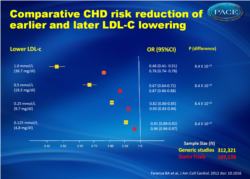Early reduction of LDL-C beneficial for CHD risk?
This study evaluated in a series of meta-analyses the association between lifelong exposure to lower LDL-C and the risk of CHD
Effect of Long-Term Exposure to Lower Low-Density Lipoprotein Cholesterol Beginning Early in Life on the Risk of Coronary Heart Disease: A Mendelian Randomization Analysis.Literature - Ference BA, Yoo W, Alesh I, et al. J Am Coll Cardiol. 2012 doi: 10.1016 - J Am Coll Cardiol. 2012 doi: 10.1016/j.jacc.2012.09.017. [Epub]
Ference BA, Yoo W, Alesh I, et al.
J Am Coll Cardiol. 2012 doi: 10.1016/j.jacc.2012.09.017. [Epub]
Background
The relationship between low-density lipoprotein cholesterol (LDL-C) and coronary heart disease has been well established. LDL-C and thereby coronary risk can be lowered by statin treatment [1], but a residual risk remains. As coronary atherosclerosis starts early in life and progresses during several years before clinical manifestation, earlier lowering of LDL-C might prevent or delay this progression [2-4]. This study evaluated in a series of meta-analyses the association between lifelong exposure to lower LDL-C and the risk of CHD mediated by 9 single-nucleotide polymorphisms (SNPs) in 6 different genes. The results of these Mendelian randomization studies were analyzed to quantify the effect of long-term exposure to lower LDL-C on the risk of CHD and compare it with the effect of lowering LDL-C during treatment with a statin started later in life.
Main results
- Long term exposure to lower LDL-C was associated with a 54.5% (95% CI:48.8%-59.5%) reduction in the risk of CHD for each mmol/l (38.7 mg/dl) lower LDL-C
- Prolonged exposure to lower LDL-C beginning early in life is associated with a 3-fold greater reduction in CHD risk for each unit lower LDL-C than treatment with a statin started later in life (p=8.43x10-19).
Conclusion
Lowering LDL-C earlier in life can reduce CHD risk substantially more than beginning later, as currently is common practice. This effect appears to be independent of the mechanism by which LDL-C is lowered.References
1. Cholesterol Treatment Trialists’ (CTT) Collaboration. Efficacy and safety of more intensive lowering of LDL cholesterol: a meta-analysis of data from 170,000 participants in 26 randomised trials. Lancet 2010;376:1670–81.2. Brown MS, Goldstein JL. Lowering LDL—not only how low, but how long? Science 2006;311:1721–3.
3. Domanski M, Lloyd-Jones D, Fuster V, Grundy S. Can we dramatically reduce the incidence of coronary heart disease? Nat Rev Cardiol 2011;8:721–5.
4. Steinberg D. Earlier intervention in the management of hypercholesterolemia: what are we waiting for? J Am Coll Cardiol 2010;56:627–9.
Abstract
Objectives:The purpose of this study was to estimate the effect of long-term exposure to lower plasma low-density lipoprotein cholesterol (LDL-C) on the risk of coronary heart disease (CHD).
Background:
LDL-C is causally related to the risk of CHD. However, the association between long-term exposure to lower LDL-C beginning early in life and the risk of CHD has not been reliably quantified.
Methods:
We conducted a series of meta-analyses to estimate the effect of long-term exposure to lower LDL-C on the risk of CHD mediated by 9 polymorphisms in 6 different genes. We then combined these Mendelian randomization studies in a meta-analysis to obtain a more precise estimate of the effect of long-term exposure to lower LDL-C and compared it with the clinical benefit associated with the same magnitude of LDL-C reduction during treatment with a statin.
Results:
All 9 polymorphisms were associated with a highly consistent reduction in the risk of CHD per unit lower LDL-C, with no evidence of heterogeneity of effect (I(2) = 0.0%). In a meta-analysis combining nonoverlapping data from 312,321 participants, naturally random allocation to long-term exposure to lower LDL-C was associated with a 54.5% (95% confidence interval: 48.8% to 59.5%) reduction in the risk of CHD for each mmol/l (38.7 mg/dl) lower LDL-C. This represents a 3-fold greater reduction in the risk of CHD per unit lower LDL-C than that observed during treatment with a statin started later in life (p = 8.43 × 10(-19)).
Conclusions:
Prolonged exposure to lower LDL-C beginning early in life is associated with a substantially greater reduction in the risk of CHD than the current practice of lowering LDL-C beginning later in life.

